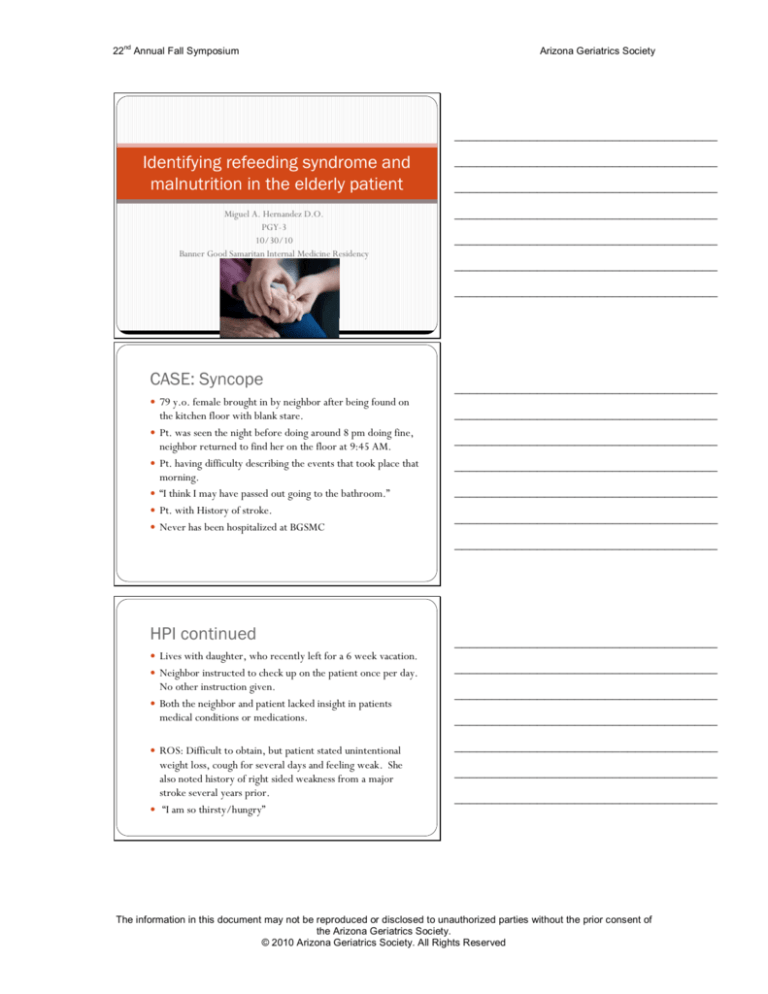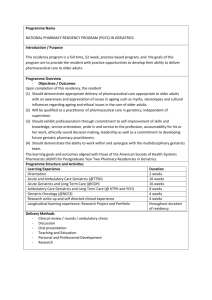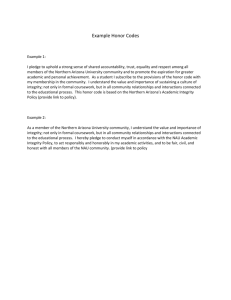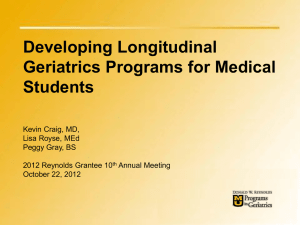
nd
22 Annual Fall Symposium
Arizona Geriatrics Society
___________________________________
Identifying refeeding syndrome and
malnutrition in the elderly patient
___________________________________
Miguel A. Hernandez D.O.
PGY-3
10/30/10
Banner Good Samaritan Internal Medicine Residency
___________________________________
___________________________________
___________________________________
___________________________________
___________________________________
CASE: Syncope
79 y.o. female brought in by neighbor after being found on
the kitchen floor with blank stare.
Pt. was seen the night before doing around 8 pm doing fine,
neighbor returned to find her on the floor at 9:45 AM.
Pt. having difficulty describing the events that took place that
morning.
“I think I may have passed out going to the bathroom.”
Pt. with History of stroke.
Never has been hospitalized at BGSMC
___________________________________
___________________________________
___________________________________
___________________________________
___________________________________
___________________________________
___________________________________
HPI continued
Lives with daughter, who recently left for a 6 week vacation.
Neighbor instructed to check up on the patient once per day.
No other instruction given.
Both the neighbor and patient lacked insight in patients
medical conditions or medications.
ROS: Difficult to obtain, but patient stated unintentional
weight loss, cough for several days and feeling weak. She
also noted history of right sided weakness from a major
stroke several years prior.
“I am so thirsty/hungry”
___________________________________
___________________________________
___________________________________
___________________________________
___________________________________
___________________________________
___________________________________
The information in this document may not be reproduced or disclosed to unauthorized parties without the prior consent of
the Arizona Geriatrics Society.
© 2010 Arizona Geriatrics Society. All Rights Reserved
nd
22 Annual Fall Symposium
Arizona Geriatrics Society
Physical exam
___________________________________
Vitals: 5 feet, 35 kg, Temp 36.5, 59, 17, 99% RA, 189/113
GEN: oriented to self, confused, Cachectic, mild distress
HEENT: PERRLA, EOMI, No JVD, no masses, Poor dentition, oropharynx dry
HEART: RR no m/r/g, occasional skipped beat
LUNGS: Coarse breath sounds b/l crackles on Left side
Abdomen: No TTP, bsx4, no masses
Back: stage 1 decubitus ulcer
EXT: mild pitting of the ankles otherwise no abnormalities
SKIN: poor skin turgor
Neuro: 3/5 right sided weakness U&L ext., 4/5 Left side
Could not follow instructions for coordination. Could not assess gait. No
pronator drift, hyporeflexic
___________________________________
___________________________________
___________________________________
___________________________________
___________________________________
___________________________________
Physical exam
___________________________________
Vitals: 5 feet, 35 kg, Temp 36.5, 59, 17, 99% RA, BP189/113
GEN: oriented to self, confused, Cachectic, mild distress
HEENT: PERRLA, EOMI, No JVD, no masses, Poor dentition, oropharynx dry
HEART: RR no m/r/g, occasional skipped beat
LUNGS: Coarse breath sounds b/l crackles on Left side
Abdomen: No TTP, bsx4, no masses
Back: stage 1 decubitus ulcer
EXT: mild pitting of the ankles otherwise no abnormalities
SKIN: poor skin turgor
Neuro: 3/5 right sided weakness U&L ext., 4/5 Left side
Could not follow instructions for coordination. Could not assess gait. No
pronator drift, hyporeflexic
___________________________________
___________________________________
___________________________________
___________________________________
___________________________________
___________________________________
Labs
10.3
8.0
130
___________________________________
93
30.9
___________________________________
19
490
255
3.2
28
0.84
AG: 9, AST<3, T. Bili: 0.3,
UA: 1-5 wbc, neg leukocyte esterase, negative nitrites, negative ketones, glucose 1,000
___________________________________
___________________________________
___________________________________
___________________________________
___________________________________
The information in this document may not be reproduced or disclosed to unauthorized parties without the prior consent of
the Arizona Geriatrics Society.
© 2010 Arizona Geriatrics Society. All Rights Reserved
nd
22 Annual Fall Symposium
Arizona Geriatrics Society
Labs
10.3
8.0
130
___________________________________
93
___________________________________
19
490
255
30.9
3.2
28
0.84
AG: 9, AST<3, T. Bili: 0.3,
UA: 1-5 wbc, neg leukocyte esterase, negative nitrites, negative ketones, glucose 1,000
AIC: 14.1 = 380-400 average
Troponins: mildly elevated x 3
CXR: Left lower lobe infiltrate.
___________________________________
___________________________________
___________________________________
___________________________________
___________________________________
CT of head: no acute intracranial process
Hospital course 1st 24 hours
Pt. was given 1 L NS in the ER, then continously at
100ml/hour
Pt. was pancultured and then started on Ceftriaxone and
Azithromycin for concern of CAP.
Blood pressure corrected conservatively so at least less than
180/100.
Pt. placed on Insulin: First 24 hours the patient required 42
units of TDD insulin
___________________________________
___________________________________
___________________________________
___________________________________
___________________________________
___________________________________
___________________________________
___________________________________
Pt. or neighbor did not know names of medications or
pharmacy.
Asked patients favorite store names.
Several pharmacies called that evening.
Pt. on Metformin, plavix, HCTZ, has not had them filled
since February >6 months ago.
Placed Cardiology and Speech consults
___________________________________
___________________________________
___________________________________
___________________________________
___________________________________
___________________________________
The information in this document may not be reproduced or disclosed to unauthorized parties without the prior consent of
the Arizona Geriatrics Society.
© 2010 Arizona Geriatrics Society. All Rights Reserved
nd
22 Annual Fall Symposium
Next 24-48 hours
Pt. became more lucid
Neighbor warned the Medicine team that daughter is coming into
town from her vacation and sounded upset.
Arizona Geriatrics Society
___________________________________
___________________________________
Daughter is MPOA (unkempt appearance, directs blame torwards
mother)
“It’s not my fault my mom doesn’t take her meds.”
“I can’t handle her anymore. She is too much work.”
“I don’t want her back when she comes out of the hospital.”
___________________________________
___________________________________
___________________________________
___________________________________
___________________________________
___________________________________
Pt. acting more distant and guarded after daughter
visits. Not answering questions without looking for
approval.
Daughter gives consent for cardiac evaluation
(Lexiscan and Cath)
Daughter no longer wants to make medical decisions
as she wants to get back to her vacation and with the
patients agreement, signs over MPOA paperwork to
neighbor friend.
___________________________________
___________________________________
___________________________________
___________________________________
___________________________________
___________________________________
___________________________________
Cardiology evaluates the patient and she has a Cath.
Gives recommendations for medical management only.
Daughter leaves again for vacation.
After daughter leaves, patient acutely improves ie, more
lucid, joking with staff.
Nursing staff notices patient has voracious appetite.
Neighbor is actually close friend of over 20 years.
___________________________________
___________________________________
___________________________________
___________________________________
___________________________________
___________________________________
The information in this document may not be reproduced or disclosed to unauthorized parties without the prior consent of
the Arizona Geriatrics Society.
© 2010 Arizona Geriatrics Society. All Rights Reserved
nd
22 Annual Fall Symposium
DAY 3-4
Day 3 patient electrolytes very difficult to control.
Pt. is now hypokalemic, hypoglycemic, and
hypophosphatemic.
Arizona Geriatrics Society
___________________________________
___________________________________
___________________________________
___________________________________
Insulin requirements have decreased by 60 percent within 72
hours.
___________________________________
___________________________________
___________________________________
What is happening to patient?
A. Renal failure
B. Somogyi Effect
C. HHNS Hyperosmolar Hyperglycemic Nonketotic state
D. Refeeding syndrome
___________________________________
___________________________________
___________________________________
___________________________________
___________________________________
___________________________________
___________________________________
What is happening to patient?
A. Renal failure
B. Somogyi Effect
C. HHNS Hyperosmolar Hyperglycemic Nonketotic state
D. Refeeding syndrome
___________________________________
___________________________________
___________________________________
___________________________________
___________________________________
___________________________________
___________________________________
The information in this document may not be reproduced or disclosed to unauthorized parties without the prior consent of
the Arizona Geriatrics Society.
© 2010 Arizona Geriatrics Society. All Rights Reserved
nd
22 Annual Fall Symposium
Refeeding syndrome
Potentially fatal
Rapid changes in fluids and electrolytes particularly
phosphate.
Occurs when patients who are malnourished are given oral,
enteral or parenteral feedings too rapidly.
Days up to 3 weeks for symptoms to occur.
Malnourished patients can have depleted intracellular
phosphate stores.
Neurologic, pulmonary, cardiac, neuromuscular, and
hematologic complications.
Arizona Geriatrics Society
___________________________________
___________________________________
___________________________________
___________________________________
___________________________________
___________________________________
___________________________________
Mechanism of Action
Sudden shift from fat to carbohydrate metabolism.
Formation of phosphorylated carbohydrate compounds in the
liver and skeletal muscle.
Depletion of intracellular ATP and 2,3-diphosphoglycerate
in RBC’s.
Cellular dysfunction and inadequate oxygen delivery to the
body's organs.
Increase in insulin levels after refeeding which leads to
increased cellular uptake of phosphate.
___________________________________
___________________________________
___________________________________
___________________________________
___________________________________
___________________________________
___________________________________
___________________________________
___________________________________
___________________________________
___________________________________
___________________________________
___________________________________
___________________________________
The information in this document may not be reproduced or disclosed to unauthorized parties without the prior consent of
the Arizona Geriatrics Society.
© 2010 Arizona Geriatrics Society. All Rights Reserved
nd
22 Annual Fall Symposium
Why do people with refeeding
syndrome have cardiac abnormalities?
Increased oral intake……… leads to an increase in
circulatory volume
Myocardial function is depressed secondary to decreased
myocardial mass and secondary to hypophosphatemia.
This can lead to heart failure.
Pt. is more prone to arrythmias secondary to electrolyte
abnormalities.
Arizona Geriatrics Society
___________________________________
___________________________________
___________________________________
___________________________________
___________________________________
___________________________________
___________________________________
What are the feeding recommendations to
prevent refeeding syndrome?
A. 1000 kcal/day increase by 500 cal/day
B. 50kcal/kg x 1 week then increase by 100kcal/day
C. 20kcal/kg and increase by 100 kcal /day
___________________________________
___________________________________
___________________________________
D. What the patient can tolerate, before nausea is noted.
___________________________________
E. kcal adjusted by their ideal body weight with nutrient
___________________________________
supplement drink.
___________________________________
___________________________________
What are the feeding recommendations to
prevent refeeding syndrome?
A. 1000 kcal/day increase by 500 cal/day
B. 50kcal/kg x 1 week then increase by 100kcal/day
C. 20kcal/kg and increase by 100 kcal /day
___________________________________
___________________________________
___________________________________
D. What the patient can tolerate, before nausea is noted.
___________________________________
E. kcal adjusted by their ideal body weight with nutrient
___________________________________
supplement drink.
___________________________________
___________________________________
The information in this document may not be reproduced or disclosed to unauthorized parties without the prior consent of
the Arizona Geriatrics Society.
© 2010 Arizona Geriatrics Society. All Rights Reserved
nd
22 Annual Fall Symposium
Arizona Geriatrics Society
Why was the patient so malnourished?
Why was she so cachectic?
Uncontrolled diabetes?
Malnourished?
Illness?
Why was her Diabetes so uncontrolled?
Is she taking her medications?
Who is giving her her medication?
How educated is the family in regards to nutrition and Diabetes?
___________________________________
___________________________________
___________________________________
___________________________________
___________________________________
___________________________________
___________________________________
Causes of weight loss in the elderly
Medications (eg, digoxin, theophylline, SSRI's, antibiotics)
Emotional (eg, depression, anxiety)
Alcoholism, elder abuse
Late life paranoia or bereavement
Swallowing problems
___________________________________
___________________________________
___________________________________
___________________________________
Oral factors (tooth loss, xerostomia)
Nosocomial infections (eg, tuberculosis, pneumonia)
Wandering and other dementia related factors
Hyperthyroidism, hypercalcemia, hypoadrenalism
Enteral problems (eg, esophageal stricture, gluten enteropathy)
Eating problems
Low salt, low cholesterol and other therapeutic diets
Social isolation, stones (chronic cholecystitis)
___________________________________
___________________________________
___________________________________
___________________________________
___________________________________
___________________________________
___________________________________
___________________________________
___________________________________
___________________________________
Guigoz, Y, Vellas, B, Garry Nutr Rev. 1996; 54: S59
The information in this document may not be reproduced or disclosed to unauthorized parties without the prior consent of
the Arizona Geriatrics Society.
© 2010 Arizona Geriatrics Society. All Rights Reserved
nd
22 Annual Fall Symposium
Arizona Geriatrics Society
Why was the patient so malnourished?
Friend stated when she went back to the house to pick up some
items. There was no food in the house. Just sweets found above
the refrigerator.
Why was her Diabetes so uncontrolled?
Friend stated daughter flushed all her medications down the toilet.
“She doesn’t take them anyway”
Friend was very concerned about the well being of the patient.
Did not want to let us know what was going on for concern of her
own well being.
___________________________________
___________________________________
___________________________________
___________________________________
___________________________________
___________________________________
___________________________________
What falls in the criteria of elder
abuse?
Elder mistreatment is perpetrated by those with an ongoing
relationship that involves an expectation of responsibility toward the
victim. Abuse, neglect, and financial exploitation by strangers are
not considered elder mistreatment unless someone who is expected to
be responsible for the victim, such as a caretaker, breaches a duty to
protect the elder.
___________________________________
___________________________________
___________________________________
___________________________________
___________________________________
___________________________________
___________________________________
ABUSE
Willful infliction of physical pain or injury or unnecessary
restraint (physical abuse),
Willful nonconsensual sexual contact (sexual abuse)
Willful infliction of emotional harm (psychological abuse).
___________________________________
___________________________________
___________________________________
___________________________________
___________________________________
___________________________________
___________________________________
The information in this document may not be reproduced or disclosed to unauthorized parties without the prior consent of
the Arizona Geriatrics Society.
© 2010 Arizona Geriatrics Society. All Rights Reserved
nd
22 Annual Fall Symposium
Arizona Geriatrics Society
Neglect
Neglect -Failure of a person to provide for the needs and
protection of a vulnerable elder. Duty to provide.
Abandonment - Desertion of a vulnerable elderly person by a
caregiver or caretaker
Self-neglect – Failure of a vulnerable elder to provide for his
or her own care and protection. Self-neglect is said to be a
failure of the elder to thrive in their environment.
___________________________________
___________________________________
___________________________________
___________________________________
___________________________________
___________________________________
___________________________________
___________________________________
Prospective cohort study
___________________________________
65 years and older
9 year study
___________________________________
Patients referred to APS- Shorter survival after adjusting for
other factors associated with increased mortality.
3.1 times more likely to die with abuse.
1.7 times more likely to die with neglect.
___________________________________
___________________________________
___________________________________
___________________________________
The mortality of elder mistreatment. JAMA 1998; 280:428
Lachs, Williams et al.
___________________________________
National Elder Abuse Incidence Study NEAIS Estimated 551,000 adults were subjected to abuse, neglect
and/or self-neglect in the domestic setting in 1996
Only 21 percent of cases were reported to and verified by
___________________________________
___________________________________
___________________________________
APS.
Self-neglect accounted for approximately 38 percent of the
reported cases.
___________________________________
___________________________________
___________________________________
Tatara, T. et al. The National Elder Abuse Incidence Study. The National Center on Elder Abuse.
The information in this document may not be reproduced or disclosed to unauthorized parties without the prior consent of
the Arizona Geriatrics Society.
© 2010 Arizona Geriatrics Society. All Rights Reserved
nd
22 Annual Fall Symposium
Arizona Geriatrics Society
What are the risk factors and warning signs
of neglect/Abuse?
___________________________________
___________________________________
___________________________________
___________________________________
to
___________________________________
___________________________________
___________________________________
___________________________________
___________________________________
___________________________________
___________________________________
___________________________________
___________________________________
___________________________________
www.uptodate.com
Screening for elderly abuse
1992 AMA proposed that clinicians in all practice settings
screen geriatric patients to identify abuse.
Patients should be interviewed by themselves to avoid
intimidation.
Patients should be questioned about family composition and
living arrangements.
Patients should be asked directly about abuse, neglect or
exploitation.
___________________________________
___________________________________
___________________________________
___________________________________
___________________________________
___________________________________
___________________________________
Aravanis, SC, Adelman, et al. Diagnostic and treatment guidelines on elder abuse and neglect. Arch
Fam Med 1993
The information in this document may not be reproduced or disclosed to unauthorized parties without the prior consent of
the Arizona Geriatrics Society.
© 2010 Arizona Geriatrics Society. All Rights Reserved
nd
22 Annual Fall Symposium
Arizona Geriatrics Society
What are screening questions for
elderly abuse?
Has anyone at home ever hurt you?
Has anyone ever touched you without your consent?
Has anyone taken anything that was yours without asking?
Has anyone ever scolded or threatened you?
___________________________________
___________________________________
___________________________________
Have you signed any documents that you didn't understand?
___________________________________
Are you afraid of anyone at home?
___________________________________
Are you alone a lot of the time?
Has anyone ever failed to help you take care of yourself when
you needed help?
___________________________________
Capacity
Capacity for self-care and protection — Ability to make and carry
out decisions regarding one's self care and protection.
Decisional capacity
Communicate a choice
Understand the relevant information
Appreciate the situation and its consequences
Reason about treatment options
Executive capacity
The ability to execute one's decisions
What are the rules in reporting elderly
abuse?
___________________________________
In all but Colorado, New Jersey, New York, North Dakota, South
Dakota, and Wisconsin, reporting is mandatory.
Penalties for failure to report suspected abuse exist in 38 states
and the District of Columbia.
Mandatory reporting requires a clinician to report suspected abuse
even if a competent elder patient specifically asks that the abuse
not be reported.
Except Puerto Rico and South Dakota physician is given immunity
from any civil or criminal liability for reporting and testifying
about suspected elder abuse, neglect, self-neglect or exploitation,
so long as the communications are made in good faith.
___________________________________
___________________________________
___________________________________
___________________________________
___________________________________
___________________________________
___________________________________
___________________________________
___________________________________
___________________________________
___________________________________
___________________________________
___________________________________
___________________________________
The information in this document may not be reproduced or disclosed to unauthorized parties without the prior consent of
the Arizona Geriatrics Society.
© 2010 Arizona Geriatrics Society. All Rights Reserved
nd
22 Annual Fall Symposium
Arizona Geriatrics Society
Who to call?
Adult protection services
American Bar Association Commission on Law and Aging
National Center on Elder Abuse
Long-Term Care Ombudsman Resource Center
Area agency on Aging
Call local authorities if you suspect current abuse.
___________________________________
___________________________________
___________________________________
___________________________________
___________________________________
___________________________________
___________________________________
References
___________________________________
Lachs, Williams et al, The mortality of elder mistreatment.
JAMA 1998; 280:428
Aravanis, SC, Adelman, et al. Diagnostic and treatment
guidelines on elder abuse and neglect. Arch Fam Med 1993
Tatara, T. et al. The National Elder Abuse Incidence Study.
The National Center on Elder Abuse.
www.uptodate.com
Agarwal, Kathryn et al. Failure to Thrive in Elderly Adults,
uptodate
Halphen, John Elder Mistreatment: Abuse, Neglect and
Financial Exploitation. Uptodate.
Questions?
___________________________________
___________________________________
___________________________________
___________________________________
___________________________________
___________________________________
___________________________________
___________________________________
___________________________________
___________________________________
___________________________________
___________________________________
___________________________________
The information in this document may not be reproduced or disclosed to unauthorized parties without the prior consent of
the Arizona Geriatrics Society.
© 2010 Arizona Geriatrics Society. All Rights Reserved








